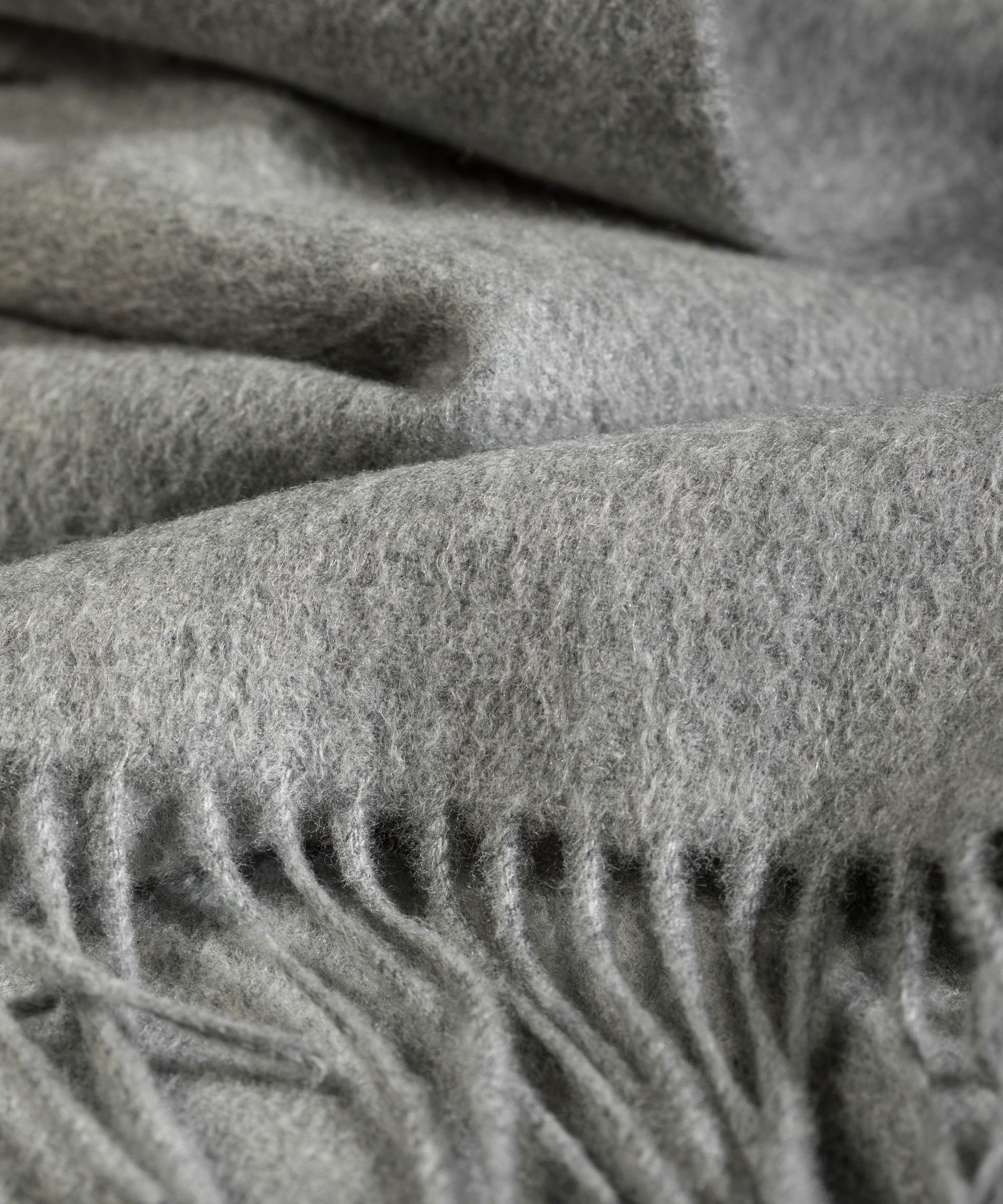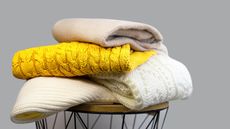How to wash cashmere at home – experts explain how to keep it soft and cozy after every wash
Experts explain how to wash cashmere are home to keep this luxurious fabric looking its best for longer
- (opens in new tab)
- (opens in new tab)
- (opens in new tab)
- Sign up to our newsletter Newsletter


Cashmere wool is a wonderful luxury to add to both your home and your closet. If you are lucky enough to own this wonderful fabric you may be wondering how to wash cashmere at home to keep it fresh and maintain its fluffiness.
Given that cashmere is the material of choice for the best throw blankets and the most comfortable clothes, learning how to wash this fabric is essential. Much like how to wash a woolen blanket, washing cashmere involves a gentle hand and plenty of patience to clean properly and maintain its fluffiness and characteristic softness.
Here, experts at international cashmere specialists House of Bruar (opens in new tab) have explained how to wash cashmere at home without ruining its delicate fibers.
How to wash cashmere at home

When investing in cashmere you are also investing in caring for cashmere. Much unlike how to wash fleece, cashmere cannot simply be thrown in a washing machine to freshen up on a whim. You are very unlikely to find any convenient laundry symbols on your cashmere pieces either.
'Due to its delicate nature, the best method of cleaning your cashmere piece is gently by hand,' explains Lorna Meikle, ladieswear buyer at House of Bruar. 'As tempting as it may be, even the hand-wash setting on your washing machine can be too vigorous for the fine cashmere fibers.
'Spot cleaning can help to prolong the life of a garment you wear regularly, however, if you plan to store your cashmere for a prolonged period, it is best to give it a thorough clean. It may not look dirty, but any trapped particles in the fibers, such as dust, skin, or hair, can attract moths. The last thing you want is to find your favorite cardigan full of holes!'
'To begin, find a clean bowl or sink. This must be absolutely devoid of food, dirt, or any cleaning chemicals, as this residue could damage your cashmere,' Lorna explains. 'We recommend having a dedicated bowl for the hand-washing of cashmere and knitwear for this reason. Place your garment in lukewarm water with a small amount of gentle detergent. Ideally, you should use a specially-formulated cashmere shampoo [such as this top-rated one H&G found on Amazon] (opens in new tab) for the best results and the least risk. Once you add the detergent, ensure that it is fully dissolved in the water before adding your clothing. Move the garment around gently and soak for up to 30 minutes, although five minutes is often enough time.
'Turn your garment inside out and squeeze gently to remove excess water. Do not wring out the garment, however,' Lorna warns, 'as this can stretch the delicate fibers and lead to damage and misshaping! Each garment should be washed separately to avoid any color bleeding and to allow you to give the cashmere the attention it deserves.
'Thoroughly rinse the garment in a new bowl of water at the same temperature used initially. Once again, ensure that the bowl is completely clean and free of any residue, especially anything that might have been dislodged from the garment.'

As with many soft materials and natural sustainable fabrics, cashmere is prone to occasionally pilling or 'bobbling' with use. Luckily, this is nothing to worry about, as Lorna explains.
'If you notice small balls of fibers on the surface of your garment, don’t be alarmed. Wools can sometimes shed small fibers during initial wear, and softer fabrics such as cashmere are more prone to this than others,' they explain. 'They can also happen in response to friction, which can occur when another, coarser material is worn against the garment, such as wool or synthetic fibers. This is not an indication of a low-quality garment,' Lorna adds, 'it is merely loose fibers working their way out of the garment. They will naturally disappear during the washing process. Regular washing will minimize the appearance of these bobbles.
'You can also use a cashmere comb to remove bobbles if they don’t come off when you wash your item. They are specially designed to remove pills while helping to preserve the fabric. To use a cashmere comb, first, lay your clothing on a flat surface. Gently pass the comb over the bobbles and repeat this motion, making sure to always move in the same direction, until the pills are picked up by the teeth of the comb and removed.'
How to dry cashmere at home

Although you may be wondering what the delicate setting on a tumble dryer is and if it is okay for delicate fabrics, using this for cashmere would be a huge mistake, Lorna cautions. 'When drying your garment, under no circumstances tumble dry – the cashmere will shrink and become damaged.'
Drying cashmere is a more complicated process than drying any other fabric due to the amount of care required. 'Once you have rinsed and squeezed out some of the excess water, it is recommended that you re-shape it to its original size, and dry it flat over a towel. Avoid radiators, direct heat, and sunlight. And, ideally, do not hang out to dry as this can also stretch and damage the fibers.
'To iron, any creases from your cashmere, press the garment under a damp cloth with the iron at the lowest possible setting,' Lorna adds.
How to store cashmere to prevent damage

In warmer months you may well be looking to store your cashmere away so that is ready to make a house look cozy in the fall and winter periods. Storing this impressive fabric, however, is not as simple as popping it in your linen closet, however.
'As mentioned earlier, before storing for any length of time, you should ensure your cashmere is thoroughly cleaned to avoid attracting moths and other insects,' says Lorna. 'De-creasing and de-pilling before storage will also extend the lifespan and quality of your cashmere.
'Wearable garments should be stored inside out in a dust-free and well-aired cupboard, away from direct sunlight and any risk of dampness. A dedicated storage bag is highly recommended to keep your cashmere as new.'
Is it better to hand wash or dry clean cashmere?
It is always best to hand wash cashmere to maintain this delicate materials softness and to make sure it is not damaged or stretched in a machine. Hand washing provides more control over the luxury material too, meaning you can easily spot-clean your blankets and clothes.
What detergent should I use on cashmere?
When washing cashmere at home you should avoid regular laundry detergent to prevent damaging the fibers. Instead, use a special delicate wool wash or even baby shampoo to gently wash cashmere by hand and maintain the materials signature softness.

Chiana is a junior writer for Homes & Gardens having joined Future plc as a new graduate in 2022 after achieving a 1st class degree in Literature at university. She first became interested in design as a child after spending her summers helping her parents redecorate her childhood home. As a long-time reader of Future’s homes titles, Chiana is constantly finding new inspiration at work as she focuses on emerging trends, how-to’s, and news pieces.
-
-
 How to remove lint from clothes – and restore them to their former glory
How to remove lint from clothes – and restore them to their former gloryWe explore six expert solutions for removing lint from clothes
By Chiana Dickson • Published
-
 Will grass seed grow after a frost? Experts offer their cold weather lawn growing tips
Will grass seed grow after a frost? Experts offer their cold weather lawn growing tipsAvoid disappointment and costly mistakes by learning whether grass seed will grow after a frost, plus what you should do to protect it
By Jill Morgan • Published

